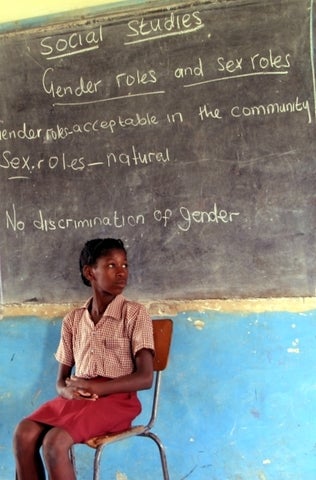News
Sexuality education offers life-saving lessons to Zambia’s young people
- 13 April 2017
News
LUSAKA, Zambia – “I have seen girls become pregnant, become victims of violence and become HIV-positive, and I don't want to become one of those girls,” said 13-year-old Lydia Mwelwa, a student at Kabulonga Basic School in Lusaka, Zambia’s capital.
“I’m happy they have taught us in school how we girls can protect ourselves,” she added.
She and her classmates are learning about comprehensive sexuality education after teachers at the school received training from UNFPA.
Adolescents in Zambia, especially girls, face persistent barriers to sexual and reproductive health services and information. Stigma in the community and discrimination by health care providers keep many from receiving the care and knowledge they need to protect themselves.

As a result, the country faces high teen pregnancy and HIV rates. There are some 145 birth per 1,000 adolescent girls – a rate nearly three times the global average. HIV prevalence in Zambia is 12.9 per cent, among the highest in the world.
Gender-based violence is also a major concern. Some 47 per cent of women who were, or had been, married reported they had experiencing physical, sexual or emotional violence from their partner, according to a 2013 survey.
And Zambia’s teen marriage rates are also staggering: Seventeen per cent of girls between the ages of 15 and 19 are married, according to the survey.
These young brides are vulnerable to early pregnancies, which can put their health at risk.
Comprehensive sexuality education equips young people to deal with all of these issues, covering not only human anatomy and disease prevention but also human rights, gender equality, communication skills and respectful relationships.
Emade Sakala, head teacher at Kabulonga Basic School, said, “For a long time, learners have been hungry for information that is now being delivered through comprehensive sexuality education in school.”
Comprehensive sexuality education was introduced into Zambia’s education curriculum in 2014, with technical guidance and support from UNFPA and other partners.
Launched by the Ministry of Education, the lessons were integrated into the coursework for grades 5 through 12.
Now, UNFPA is working with the United Nations Educational, Scientific and Cultural Organization (UNESCO) to help teachers and schools better deliver these messages in the classroom. Teachers are receiving face-to-face and online training to help them confidently and sensitively present this information to their students.
Health workers are also receiving training to help them meet the needs of young people without stigma or bias.
To date, UNFPA and UNESCO have reached more than 34,000 teachers and about 200 health workers.
The teachers’ hard work is paying off.
Students are not only learning how to prevent transmission of HIV and unintended pregnancy. They are also embracing the idea of gender equality, teachers said, and relying less on gender stereotypes that can be harmful to both boys and girls.
“We have seen a significant shift in gender norms among the students,” said Chipo Chisango, a teacher at Twalumba Primary School in Lusaka.
“We see critical thinking, confidence, assertiveness, communication, respect for others and responsible sexual behaviours,” he added.
– Precious Zandonda